关于一类微分方程周期解的存在性的注记(英文)
- 格式:pdf
- 大小:165.77 KB
- 文档页数:7
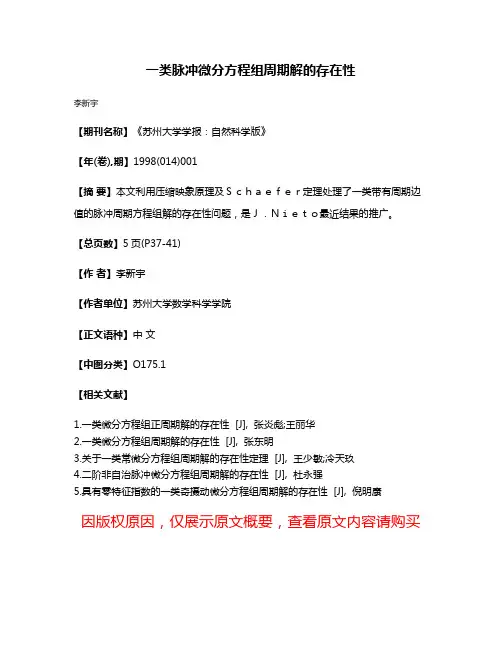
一类脉冲微分方程组周期解的存在性
李新宇
【期刊名称】《苏州大学学报:自然科学版》
【年(卷),期】1998(014)001
【摘要】本文利用压缩映象原理及Schaefer定理处理了一类带有周期边值的脉冲周期方程组解的存在性问题,是J.Nieto最近结果的推广。
【总页数】5页(P37-41)
【作者】李新宇
【作者单位】苏州大学数学科学学院
【正文语种】中文
【中图分类】O175.1
【相关文献】
1.一类微分方程组正周期解的存在性 [J], 张炎彪;王丽华
2.一类微分方程组周期解的存在性 [J], 张东明
3.关于一类常微分方程组周期解的存在性定理 [J], 王少敏;冷天玖
4.二阶非自治脉冲微分方程组周期解的存在性 [J], 杜永强
5.具有零特征指数的一类奇摄动微分方程组周期解的存在性 [J], 倪明康
因版权原因,仅展示原文概要,查看原文内容请购买。
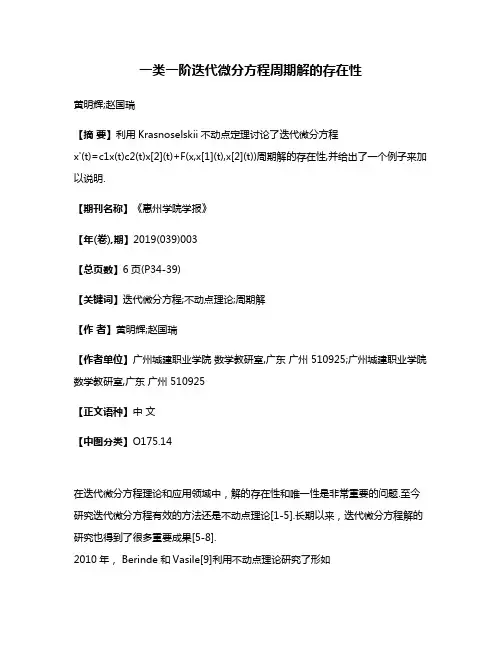
一类一阶迭代微分方程周期解的存在性黄明辉;赵国瑞【摘要】利用Krasnoselskii不动点定理讨论了迭代微分方程x'(t)=c1x(t)c2(t)x[2](t)+F(x,x[1](t),x[2](t))周期解的存在性,并给出了一个例子来加以说明.【期刊名称】《惠州学院学报》【年(卷),期】2019(039)003【总页数】6页(P34-39)【关键词】迭代微分方程;不动点理论;周期解【作者】黄明辉;赵国瑞【作者单位】广州城建职业学院数学教研室,广东广州 510925;广州城建职业学院数学教研室,广东广州 510925【正文语种】中文【中图分类】O175.14在迭代微分方程理论和应用领域中,解的存在性和唯一性是非常重要的问题.至今研究迭代微分方程有效的方法还是不动点理论[1-5].长期以来,迭代微分方程解的研究也得到了很多重要成果[5-8].2010年, Berinde和Vasile[9]利用不动点理论研究了形如一阶迭代微分方程解的存在性,其初始条件为 x ( t0 ) = x 0.2014年,Zhang[10]利用Schauder不动点定理研究了形如周期解的存在性问题,其初始条件为本文考虑利用Krasnoselskii不动点定理如下一类一阶迭代微分方程周期解的存在唯一性,其中是连续有界函数,满足Lipschitz条件,1 主要结论设集合和定义范数是一个Banach空间.定理1[11]设M 是Banach空间的一个有界凸非空子集.假设映射A、B将M映射到M,若(ⅰ)对所有x,yM∈,有AxByM+∈,(ⅱ)A是连续的和AM包含在M的一个紧子集上,(ⅲ)B是压缩映射,则存在zM,使得为了应用定理1,需要定义Banach空间的一个有界凸非空子集和两个映射:一个是全连续和一个是压缩映射.对于P , L ≥ 0 ,定义集合则是 TP的一个有界凸非空子集.引理1[1]假设则引理2 假设1 0c≠ ,是方程(3)的解当且仅当其中证明方程(3)两边同时乘以并从t到t T+ 积分,得等式两边同时除以,并通过加以整理,得以上每一步都是可逆的.证明完成.为了给出本文主要结果,假设以下条件成立:(H3)对任意存在正常数,m M,使得(H4)存在使得对任意tR∈,有定义映射H由引理2可知映射H的不动点是方程(3)的解,反之亦然.为了利用定理1,设映射如下引理3 假设(H1)-(H4)成立,则是全连续.证明首先证是全连续.显然,若,故Ax是周期为T的周期函数.接着,证明A是连续的.设使得当时,.由Dominated Convergence 定理[11]可得,由Dominated Convergence定理可得,当.故Ax是等度连续的.由ArzelaAscoli 定理可得,A是全连续的.故是压缩映射.定理2 假设条件(H1)-(H4)成立,且成立,则方程(3)在 P T( P, L)上至少存在一个周期为T的周期解.证明若(H1)-(H4)成立,则引理2-4成立.由引理3可得,A是连续的和AM 包含在M 的一个紧子集上.同样,由引理4可知,则B是压缩映射.任意设x,任意取则这表明.所以Krasnoselskii定理所有的条件成立.因此,存在一个不动点由引理2可知,这个不动点就是方程(3)的解,因此方程(3)有一个周期为T的解.证明完毕.定理3 除了定理1的假设之外,假设成立,则方程(3)在上有唯一解.证明设任意,有因此.由压缩映射原理可得,H在 P T( P, L)中有一个不动点,根据引理2,这个不动点就是方程(3)的唯一解.证明完毕.2 实例因此,由定理2可得,方程(10)存在一个周期的周期解.参考文献:【相关文献】[1]ZHANG W.On the differential solution of the iterated equation[J].Nonlinear Analysis,Theory,Methods and Applications,1990,15(4):387-389.[2]IBRANHIM R W.Existence and uniqueness for a class of iterative fractional differential equations[J].Advances in Difference Equations,2015(78):1-15.[3]CHENG S S.An Existence Theorem for Iterative Functional Differential Equations[J].Acta Mathematica Hungarica,2002,94(1-2):1-17.[4]黄明辉.带可积时滞的非线性中立型微分方程周期解的存在性[J].广东工业大学学报,2014,31(4):65-68.[5]黄明辉.多时滞的非线性微分方程的渐近稳定性[J].广东工业大学学报,2016,33(1):62-66.[6]MOUATAZ B M.Existence and stability of periodic solutions for nonlinear neutral differential equations with variable delay using fixed ponnttechnique[J].Acta.Univ.Palacki.Olomuc.Fac.rer.nat,2015,54(1):95-108.[7]JIN C H,LUO J W.Stability in functional differential equations established using fixed point theory[J].Nonlinear Analysis,2008,68(11):3307-3315.[8]MCRAE F A.Monotone iterative technique and existence results for fractional differential equations[J].Nonlinear Analysis TheoryMethods&Applications,2009,71(12):6093-6096.[9]BERINDE V.Existence and approximation of solutions of some first order iterative differential equations[J].Miskolc Mathematical Notes,2010,1(1):13-26.[10]ZHANG P P,GONG X B.Existence of solutions for iterative differentialequations[J].Electronic Journal of Differential Equations,2014,(2014)7:1-10.[11]Ardjouni A,Djoudi A.Existence,uniqueness and positivity of solutions for a neutral nonlinear periodic differential equation[J].Computational and Applied Mathematics,2015,34(1):17-27.。
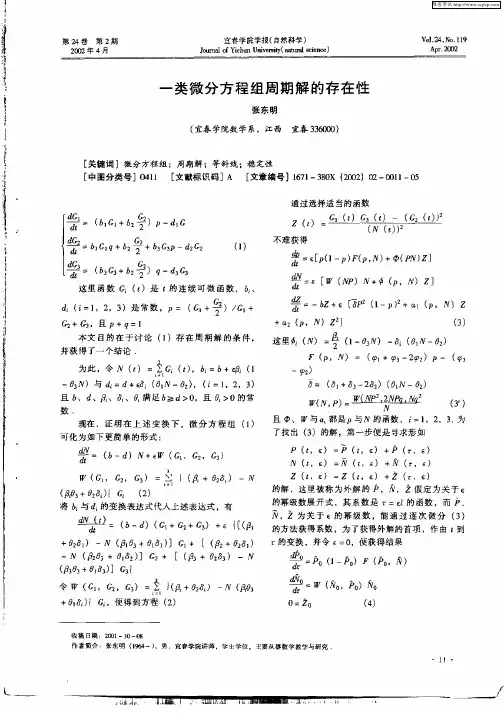
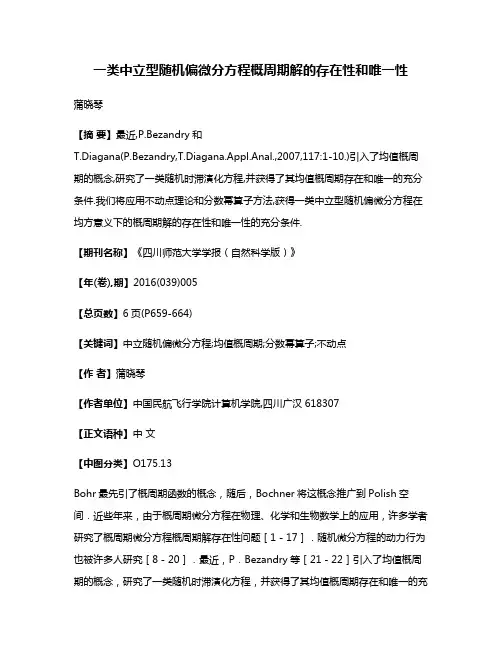
一类中立型随机偏微分方程概周期解的存在性和唯一性蒲晓琴【摘要】最近,P.Bezandry和T.Diagana(P.Bezandry,T.Diagana.Appl.Anal.,2007,117:1-10.)引入了均值概周期的概念,研究了一类随机时滞演化方程,并获得了其均值概周期存在和唯一的充分条件.我们将应用不动点理论和分数幂算子方法,获得一类中立型随机偏微分方程在均方意义下的概周期解的存在性和唯一性的充分条件.【期刊名称】《四川师范大学学报(自然科学版)》【年(卷),期】2016(039)005【总页数】6页(P659-664)【关键词】中立随机偏微分方程;均值概周期;分数幂算子;不动点【作者】蒲晓琴【作者单位】中国民航飞行学院计算机学院,四川广汉618307【正文语种】中文【中图分类】O175.13Bohr最先引了概周期函数的概念,随后,Bochner将这概念推广到Polish空间.近些年来,由于概周期微分方程在物理、化学和生物数学上的应用,许多学者研究了概周期微分方程概周期解存在性问题[1-17].随机微分方程的动力行为也被许多人研究[8-20].最近,P.Bezandry等[21-22]引入了均值概周期的概念,研究了一类随机时滞演化方程,并获得了其均值概周期存在和唯一的充分条件.应用不动点理论和分数幂算子方法,获得了一类中立型随机偏微分方程在均值概周期解的存在性和唯一性的充分条件.假设H和K为实可分的Hilbert空间,它们的范数分别记为‖·‖和‖·‖K.设(Ω,F,{Ft}t≥0,P)为完备概率空间.L2(K,H)为Hilbert-Schmidt算子,范数记为‖·‖2.Q为对称非负算子,Q∈L2(K,H),并且Q的迹有限.W(t)(t∈R)为定义在(Ω,F,{Ft}t≥0,P)上的取值在K上的Q-Wiener过程[23].L2(P,H)为强可测的,均方可积的H值随机变量的全体,显然,在范数‖X‖L2(P,H)=(E‖X‖2)1/2下为Banach空间,其中E为期望.设范数为研究如下一类中立型随机偏微分方程其中,A为Hilbert空间H上的一致指数稳定解析半群最小生成元,r≥0,f,g:R×H→H和σ:R×H→为连续函数.设A:D(A) H→H为定义在Hilbert空间H上的线性算子(T(t))t≥0的解析半群最小生成元,M和δ为正常数,满足‖T(t)‖≤Me-δt对任意t≥0.假设0∈ρ(A),那么,可以定义分数幂算子Aα对0<α<1.它是一闭线性算子,并且定义域D(Aα)在H中稠密.Hα记为Banach空间D(Aα),其范数为引理1.1[24]下列2个属性成立:(i)如果0<β<α≤1,那么Hα→Hβ并且当A的预解式为紧时,该嵌入是紧的; (ii)对0<α≤1,存在Cα以致为了获得主要结果,介绍一些定义和引理.设(B,‖·‖)为一Banach空间.定义1.1 一连续随机过程X:R→L2(P;B)称为均值概周期的,如果对每一个ε>0,存在l(ε)>0以致任何区间长度l(ε)最少存在一数τ满足下列为一些均值概周期过程的属性.引理1.2[21]如果X属于AP(R;L2(P;B)),那么:(i)映射t→E‖X(t)‖2一致连续;(ii)存在常数N>0满足E‖X(t)‖2≤N,对t∈R.引理1.3 如果X(·)∈AP(R;L2(P;B)),那么X(·-r)∈AP(R;L2(P;B)),其中r≥0为固定常数.证明和文献[25]中的相似,故省略.设CUB(R;L2(P;B))为连续有界随机过程X: R→L2(P;B)的集合,那么,容易证明在下列范数下CUB(R;L2(P;B))为Banach空间.引理1.4[21] AP(R;L2(P;B)) CUB(R; L2(P;B))为闭子空间.由上可知,AP(R;L2(P;B))在范数‖·‖∞下是Banach空间.设(B1,‖·‖B1)和(B2,‖·‖B2)为Banach空间.定义1.2 称连续函数F:R×B1→B2,(t,Y)→F(t,Y)关于t∈R是均值概周期的,对Y∈K是一致的,其中K B1是紧的,如果对任何ε>0,存在l(ε,K)>0以致对任何区间长度l(ε,K)最少存在一数τ,对任何随机过程Y:R→K满足引理1.5[21]设F:R×B1→B2,(t,Y)→F(t,Y)关于t∈R是均值概周期的,对Y∈K是一致的,其中K B1是紧的.假设F是以下列方式Lipschitz的对所有Y,Z∈B1,t∈R成立,其中M>0,那么对所有均值概周期过程Φ:R→L2(P;B1),随机过程t→F(t,Φ(t))是均值概周期的.(1)式的温和解的定义如下[26]:定义1.3 随机过程x(t):[δ,δ+a)→L2(P; H),a>0,称为(1)式在[δ,δ+a)上的温和解,如果s→AT(t-s)f(s,x(s-r))在[δ,t)可积,δ<t<δ+ a,并且满足为了获得所需结果,假设:(H1)函数g(t,x):R×H→H关于t∈R对x∈Ω(Ω H是紧的)是一致均值概周期的.存在α∈(0,1)以致(-A)αf(t,x):R×H→Hα关于t∈R对x∈Ω(Ω H是紧的)是一致均值概周期的.进一步,(-A)αf,g是以下列方式 Lipschitz的:存在 Lf和Lg满足对所有x,y∈H和t∈R成立.(H2)函数σ(t,x):R×H→L02关于t∈R对x∈Ω(Ω H是紧的)是一致均值概周期的.进一步,σ是以下列方式Lipschitz的:存在Lσ满足对所有x,y∈H和t∈R成立.定理2.1 假设(H1)和(H2)成立,并且那么(1)式在R上存在唯一均值概周期解.证明设Γ:AP(R;L2(P;H))→C(R;L2(P; H))的定义为显然,Γx(·)是连续的.定义由引理1.3、引理1.5和(H1)可知,当x为均值概周期函数时,(-A)αf(t,x(t-r))为均值概周期函数时.由引理1.2,可知(-A)αf(t,x(t-r))有界.由引理1.1和Cauchy-Schwarz不等式可得由s→AT(t-s)f(s,x(s-r))是可积的在(-∞,t)对任何t∈R,故Γ定义是合适的.由引理1.3、引理1.5和(H1)可知,当x为均值概周期函数时,(-A)αf(t,x(t-r))为均值概周期函数时.因此,对每一个ε>0存在l(ε)>0以致对任意区间长度l(ε)最少存在一个数τ满足对任何t∈R成立.同时有由上可知对每个t∈R成立,即I1x(t)均值概周期函数.下一步,证明当x是均值概周期函数I3x(t)和I4x(t)是均值概周期函数.该证明和文献[21]中的定理3.2相似,故省略.下一步证明I2x(t)是均值概周期函数.由引理1.3、引理1.5和(H1)可得,当x 是均值概周期函数,(-A)αf(t,x(t-r))是均值概周期函数.因此,对每一个ε>0存在l(ε)>0以致对任意区间长度l(ε)最少存在一个数τ满足对任何t∈R成立.由引理1.1可得因此,应用Cauchy-Schwarz不等式可得由上可知对每个t∈R成立,即I2x(t)是均值概周期函数.由上可知,Γ是AP(R;L2(P;H))对自身的映射.下面证明Γ是压缩映射.显然由于可得首先,估计上式右边第一项现在估计第二项,由引理1.1、(H1)和Cauchy-Schwarz不等式可得现在估计第三项得现在估计最后一项,应用建立在文献[27]中命题1.9的It 积分估计得因此这说明Γ(·)是压缩的.故Γ(·)存在不动点x∈AP(R;L2(P;H)),即对所有t∈R成立.固定δ∈R可得那么然而,对t≥δ,因此,x(t)是(1)式的温和解.证明完毕.致谢中国民航飞行学院面上项目(J2013-39)对本文给予了资助,谨致谢意.【相关文献】[1]HERN NDEZ E,PELICER M.Asymptotically almost periodic and almost periodic solutions for partial neutral differential equations[J].Appl Math Lett,2005,18:1265-1272.[2]HENR QUEZ H,V SQEZ C.Almost periodic solutions of abstract retarded functional -differential equations with unbounded delay[J].Acta Appl Math,1999,57(2):105-132.[3]LIU B,TUNC C.Pseudo almost periodic solutions for a class of nonlinear Duffing system with a deviating argument[J].J Appl Math Comput,2015,49:233-242.[4]ZHANG L,LI H.Weighted pseudo almost periodic solutions for differential equations with piecewise constant arguments[J].Bull Aust Math Soc,2015,92:238-250.[5]AKDAD A,EZZINBI K,SOUDEN L.Pseudo almost periodic and automorphic mild solutions to nonautonomous neutral partial evolution equations[J].Nonauton Dyn Syst,2015,2:12-30.[6]SADRATI A,ZERTITI A.Existence and uniqueness of positive almost periodic solutions for systems of nonlinear delay integral equations[J].Electron J Diff Eqns,2015,116:12.[7]CAO J,HUANG Z.Existence and exponential stability of weighted pseudo almost periodic classical solutions of integro-differential equations with analytic semigroups [J].Differ Eqns Dyn Syst,2015,23:241-256.[8]WANG W T.Positive pseudo almost periodic solutions for a class of differential iterative equations with biological background[J].Appl Math Lett,2015,46:106-110.[9]HENRIQUEZ H,CUEVAS C,CAICEDO A.Almost periodic solutions of partial differential equations with delay[J].Adv Difference Eqns,2015,2015:46-61.[10]WANG Q,LIU Z,LI Z,et al.Existence and global asymptotic stability of positive almost periodic solutions of a two-species competitive system[J].Int J Biomath,2014,7:1450040.[11]ZHUANG R,YUAN R.Weighted pseudo almost periodic solutions of N-th order neutral differential equations with piecewise constant arguments[J].Acta MathSin(Engl Ser),2014,30:1259-1272.[12]MAQBUL M,BAHUGUANA D.Almost periodic solutions for Stepanov-almost periodic differential equations[J].Differ Eqns Dyn Syst,2014,22:251-264.[13]EZZINBI K,ZABSORE I.Pseudo almost periodic solutions of infinite class for some functional differential equations[J].Appl Anal,2013,92:627-1642.[14]WANG L,SHI Y.Almost periodic solutions of abstract differential equation withimpulse and time delay in Banach space[J].Int J Appl Math Stat,2013,43:379-386.[15]VRABEL I.Almost periodic solutions for nonlinear delay evolutions with nonlocal initial conditions[J].J Evol Eqns,2013,13: 693-714.[16]DING H,LONG W,N’GU R KATA G.Existence of pseudo almost periodic solutions for a class of partial functional differential equations[J].Electron J Diff Eqns,2013,104:14.[17]XU Y.Existence and uniqueness of almost periodic solutions for a class of nonlinear Duffing system with time-varying delays[J].Electron J Qual Theory Differ Eqns,2012,80:9.[18]鲍杰,舒级.高阶广义2D Ginzburg-Landau方程的随机吸引子[J].四川师范大学学报(自然科学版),2014,37(3):298-306.[19]付颖,李扬荣.无界域上带有可加白噪音的Ginzburg-Landau方程的随机吸引子[J].西南大学学报(自然科学版),2012,37(12):37-42.[20]杜先云,陈伟.具有可加噪声的耗散KdV型方程的随机吸引子[J].四川师范大学学报(自然科学版),2012,35(5):651-655.[21]BEZANDRY P,DIAGANA T.Existence of almost periodic solutions to some stochastic differential equations[J].Appl Anal,2007,117:1-10.[22]BEZANDRY P.Existence of almost periodic solutions to some functional integro-differential stochastic evolution equations[J].Stat Probabil Lett,2008,78:2844-2849.[23]PRATO G,ZABCZYK J.Stochastic Equations in Infinite Dimensions [M].Cambridge:Cambridge Univ Press,1992.[24]PAZY A.Applied Methematical Sciences[M].New York:Springer-Verlag,1983.[25]DING H,LIANG J,N’GU R KATA G.Pseudo almost periodicity of some nonautonomous evolution equations with delay[J].Nonlinear Anal:TMA,2007,67:1412-1418.[26]LIU K.Stability of Infinite Dimensional Stochastic Differential Equations with Applications[M].London:Chapman and Hall,2004.[27]ICHIKAWA A.Stability of semilinear stochastic evolution equations[J].J Math Anal Appl,1982,90(1):12-44.。
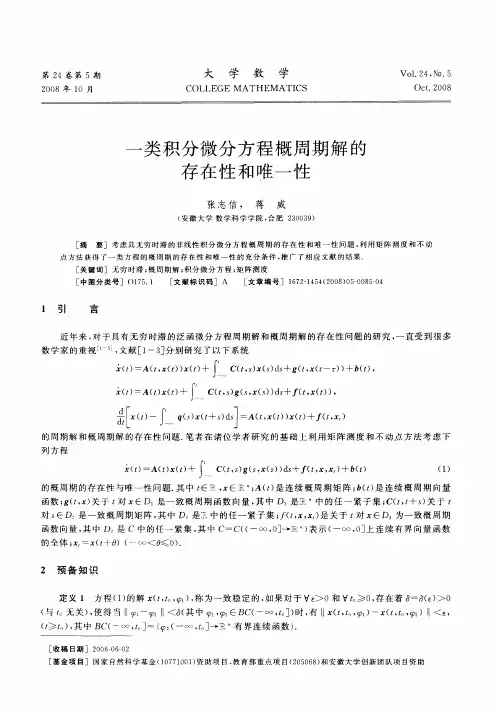
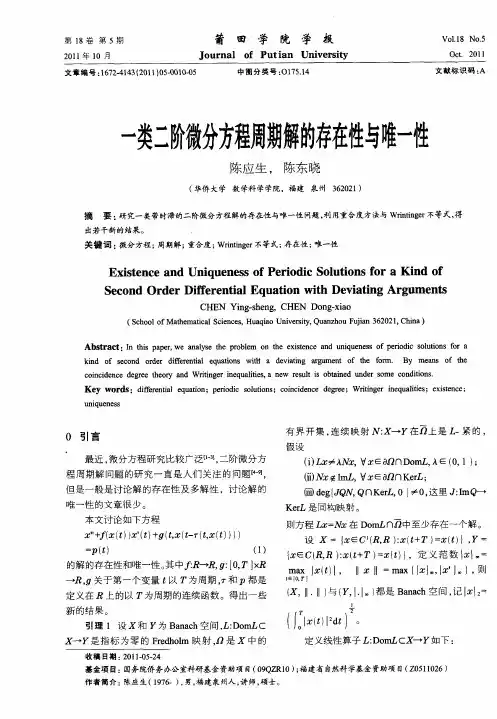
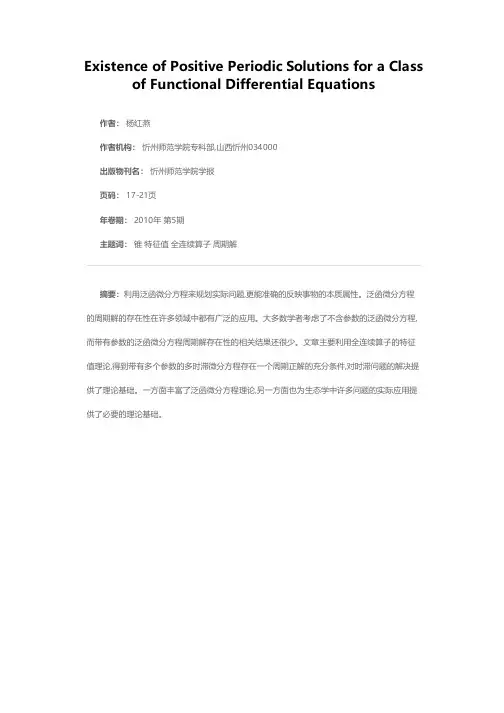
Existence of Positive Periodic Solutions for a Class of Functional Differential Equations 作者: 杨红燕
作者机构: 忻州师范学院专科部,山西忻州034000
出版物刊名: 忻州师范学院学报
页码: 17-21页
年卷期: 2010年 第5期
主题词: 锥 特征值 全连续算子 周期解
摘要:利用泛函微分方程来规划实际问题,更能准确的反映事物的本质属性。
泛函微分方程的周期解的存在性在许多领域中都有广泛的应用。
大多数学者考虑了不含参数的泛函微分方程,而带有参数的泛函微分方程周期解存在性的相关结果还很少。
文章主要利用全连续算子的特征值理论,得到带有多个参数的多时滞微分方程存在一个周期正解的充分条件,对时滞问题的解决提供了理论基础。
一方面丰富了泛函微分方程理论,另一方面也为生态学中许多问题的实际应用提供了必要的理论基础。
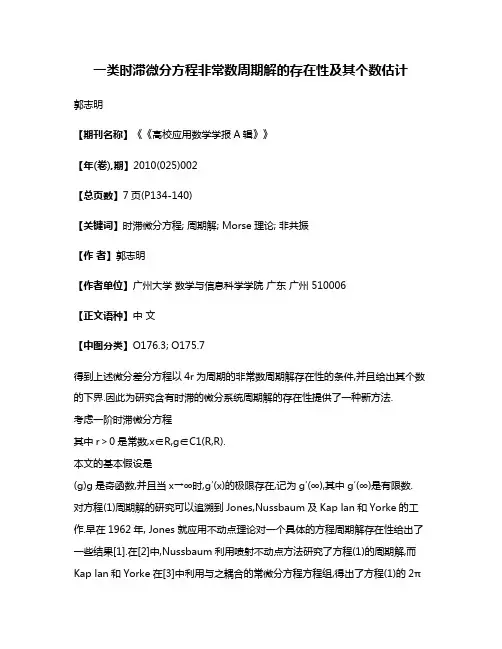
一类时滞微分方程非常数周期解的存在性及其个数估计郭志明【期刊名称】《《高校应用数学学报A辑》》【年(卷),期】2010(025)002【总页数】7页(P134-140)【关键词】时滞微分方程; 周期解; Morse理论; 非共振【作者】郭志明【作者单位】广州大学数学与信息科学学院广东广州 510006【正文语种】中文【中图分类】O176.3; O175.7得到上述微分差分方程以4r为周期的非常数周期解存在性的条件,并且给出其个数的下界.因此为研究含有时滞的微分系统周期解的存在性提供了一种新方法.考虑一阶时滞微分方程其中r>0是常数,x∈R,g∈C1(R,R).本文的基本假设是(g)g是奇函数,并且当x→∞时,g′(x)的极限存在,记为g′(∞),其中g′(∞)是有限数. 对方程(1)周期解的研究可以追溯到Jones,Nussbaum及Kap lan和Yorke的工作.早在1962年, Jones就应用不动点理论对一个具体的方程周期解存在性给出了一些结果[1].在[2]中,Nussbaum利用喷射不动点方法研究了方程(1)的周期解,而Kap lan和Yorke在[3]中利用与之耦合的常微分方程方程组,得出了方程(1)的2π周期解的存在性.后来温立志,陈永劭,葛渭高等分别对该方程进行了研究[4-6]. 1998年,李继彬与何学中首次应用临界点理论研究方程(1)的周期解的存在性,相关文献可参阅[7-8]等.在[7-8]中,作者将方程(1)满足一定对称条件的周期解问题转化为一个相应的Ham ilton系统的周期解问题,进而应用临界点理论研究相应Ham ilton系统周期解的存在性.但是我们注意到,在一个特定的函数空间上,方程(1)是具有变分结构的微分系统.2005年,郭志明与庾建设[9]对方程(1)的周期解问题在一个特定的函数空间上直接建立变分框架,并应用伪指标理论得到了向量形式的方程(1)的周期解的多重性.2006年,Fei[10-11]应用指标理论对方程(1)作了更细致的讨论,得到了重要的研究成果.M orse理论是临界点理论的重要组成部分,它在研究具有变分结构的微分系统周期解存在性及其个数估计方面有着非常广泛的应用.而且一般说来,应用M orse理论得到的周期解含有更丰富的信息,如临界点的Morse指标或临界值的估计等.2000年,Abbondandolo在文[12]中介绍了一种新的无穷维空间M orse理论.一般说来,Hilbert空间上的强不定泛函,其临界点的M orse指标为无穷大.对于这类泛函无法直接应用经典的M orse理论,往往需要将所考虑的泛函约化到某个有限维空间上去讨论.Abbondandolo对Hilbert空间的子空间定义了一种相对维数,同时对泛函的临界点定义新的Morse指标,即E+-Morse指标.这样就可以直接在无穷维空间上应用其建立的M orse理论研究临界点的存在性及其个数.需要指出的是,这种相对M orse指标早在1995年与1997年,Fei与Qiu已经作了类似的研究[13-14].本文的目的就是利用变分方法与Abbondandolo介绍的E+-M orse理论来研究方程(1)的非常数4r周期解的存在性及其个数估计.为简单起见,取对一般情形可以通过一个时间变换将方程变为的情形.先对方程(1)建立适当的变分框架,将(1)的2π周期解转化为相应泛函的临界点,然后应用Abbondandolo的E+-M orse理论,研究方程(1)的非常数2π周期解的存在性及其个数.定义1.1 方程(1)的2π周期解x(t)称为非共振的,如果线性化方程的所有2π周期解组成的空间是由˙x(t)张成的.定义1.2 方程(1)称为在无穷远处是非共振的,如果线性方程不存在非零的2π周期解.定义1.3 记称τ(0)为方程(1)关于0的旋转数.同理1)称为方程(1)在无穷远处的旋转数.记n(2π)为方程(1)的2π非常数周期解的个数.定理1.1 假设函数g∈C1(R,R)满足条件(g),方程(1)的所有2π周期解是非共振的,并且方程(1)在无穷远处也是非共振的.则方程(1)的2π非常数周期解的个数n(2π)满足:其中[τ(∞)],[τ(0)]分别表示τ(∞),τ(0)的最大整数部分.注1 由假设(g),g(0)=0.从而x=0是方程(1)的2π周期解.如果方程(1)的所有2π周期解是非共振的,则简单计算可知,对于任意的正整数k,g′(0)=(−1)k(2k−1).类似地,如果方程(1)在无穷远处是非共振的,则对于任意的正整数k,g′(∞)=(−1)k(2k−1).从而可以得到如下推论.推论1.1 在定理1.1的假设下,当g′(0)<g′(∞)时,方程(1)至少存在个非常数的2π周期解.当g′(∞)<g′(0)时,方程(1)至少存在个非常数的2π周期解,其中#(A)表示集合A所含元素的个数,Z表示整数集.注2 在定理1.1中,方程(1)的所有2π周期解是非共振的这一假设条件是技术性的,该条件意味着方程(1)的2π周期解对应作用泛函的非退化临界点.应用退化临界点的Morse理论可以避免这一假设条件[15].由关于g的假设条件可知,泛函Φ的临界点对应于方程(1)的2π周期解.这样,我们就把寻求方程(1)的2π周期解转化为讨论(4)的临界点的存在性.下面概括Abbondandolo关于空间相对维数的一些概念及E+-M orse指标的有关结论而不加证明,详细讨论参见[12,16].设E为实的Hilbert空间,E正交分解为E=E+⊕E−,E+与E−均可以是E的无穷维子空间.定义2.1 E的两个闭子空间V,V′称为是可公度的(commensurable),如果商投影V′→E/V及V→E/V′都是紧的.可公度性是E的闭子空间上的等价关系.定义2.2 设V是E中与E−可公度的闭子空间.V的E+维数定义为由可公度性的定义,上述和式中两个被加项都是有限数.例如,如果Y是有限维的子空间且Y∩E−={0},则E+-dim(E−⊕Y)=dim Y≥0;如果Y是E−中有限余维的子空间,则E+-dim Y=−codimE−Y≤0.设F是定义在E上二次连续可微的泛函,d2F(u)表示F在u的二阶Frechet导数,则d2F(u)可以看作E上有界线性的自共轭算子.假设u是F的临界点,即F′(u)=0,如果d2F(u)是可逆的,则称u为F的非退化临界点.定义2.3 设u为F的非退化临界点,并且d2F(u)的最大负特征子空间V−与E−是可公度的,则u的E+-M orse指标(记作E+-m(u))定义为由于直接计算可得a0=0,a2k=b2k=0,k∈N.因此u可以表示为.令Ek=span{cos(2k−1)t,sin(2k−1)t},则记则E=E+⊕E−.考虑定义在E上的泛函Φ(见(4)).由于g∈C1(R,R),Φ在E上是二阶Frechet可微的,且对于任意的u∈E,∫包含在E中的所有2π周期解组成的空间是由张成的.定义2.5 方程(1)称为在无穷远处是E中非共振的,如果线性方程定义2.4 方程(1)的2π周期解x∈E称为在E中是非共振的,如果线性化方程在E中不存在非零的2π周期解.由定理1.1的假设条件,0是泛函Φ在E上的临界点,并且是非退化的.事实上,若∀ξ∈E,考虑E上的有界自共轭算子d2Φ(∞),d2Φ(∞)定义为若d2Φ(∞)最大负特征子空间为,则d2Φ(∞)在无穷远处的E+-M orse指标定义为的E+维数,即应用[16]中Theorem 5.2.1的证明方法,可得如下引理.引理2.1 假设函数g∈C1(R,R)满足条件(g),方程(1)的所有2π周期解在E中是非共振的,并且在无穷远处也是E中非共振的.则下面的Morse关系式成立其中W(λ),Q(λ)是具有非负系数的形式Laurent级数,并且设若wl>0,则方程(1)存在wl个非常数的2π周期解.定理1.1的证明将引理2.1中的M orse关系式改写为设由于qj≥0,wj≥0,若bj<0,则wj=qj−bj≥−bj>0.记m(2π)为方程(1)在E中非常数2π周期解的个数.则下面我们计算B−.首先计算E+-m(0).令d2Φ(0)的最大负特征子空间记为考虑特征值问题:容易求得,由于方程(1)的所有2π周期解在E中是非共振的,故∀k=1,2,···,当g′(0)≥ 0时,并且当k≤[τ(0)]<k>[τ(0)]时,易知因此当g′(0)< 0时,k=1,2,···,并且当k>−[τ(0)]时,<0.k≤−[τ(0)]时,>0.因此在E−中的正交补空间为从而同样,当g′(∞)>0时,E+-m(∞)=2[τ(∞)];当g′(∞)<0时,E+-m(∞)=2[τ(∞)],其中, 现考虑Morse关系式(6).不妨设g′(∞)>g′(0),g′(∞)≤g′(0)的情形可类似讨论.将M orse关系式改写为显然,B(λ)中,λ的奇次幂前的系数为−1,而偶次幂前的系数为+1.因此B(λ)中负系数的和B−为定理1.1证毕.推论1.1的证明当g′(0)<g′(∞)时,τ(0)<τ(∞),从而[τ(0)]≤[τ(∞)].根据定理1.1,方程(1)至少存在[τ(∞)]−[τ(0)]个2π周期解.不妨设[τ(0)]=j<j+1<···<j+l=[τ(∞)].记A={k∈N|g′(0)<4k−1<g′(∞)}.我们将证明#(A)=l.事实上∀p=1,2,···,l, [τ(0)]<j+p≤[τ(∞)].由于τ(0)与τ(∞)不能取整数,所以τ(0)<j+p<τ(∞).由τ(0)与τ(∞)的定义,g′(0)<4(j+p)−1<g′(∞).这说明,j+p∈A.因此,#(A)≥l.另一方面,∀k∈A,g′(0)<4k−1<g′(∞),即τ(0)<k<τ(∞).从而,[τ(0)]<k≤[τ(∞)].即存在p=1,2,···,l,使得k=l+p.因此,#(A)≤l.当g′(0)>g′(∞)时,可以类似地证明.推论1.1证毕.注3 在[3]中,Kap lan与Yorke研究了方程以4为周期解的存在性.他们假设f是奇函数,并且则当β或时,方程(10)至少存在一个4周期解.作时间变量变换并令则方程(10)变为令应用推论1.1的结论,我们有推论3.1 方程(10)存在m个以4为周期的周期解,其中显然,推论3.1推广了[3]的结论.A lower bound of the number of periodic solutions is also given.As aconsequence of this paper,a new m ethod is introduced for investigating the periodic solutions of delay diff erential equations.【相关文献】[1] Jones G J.The existence of periodic solutions of f′(x)=−af(x−1)[1+f(x)][J].J M ath Anal App l,1962,5:435-450.[2] Nussbaum R D.Periodic solutions of som e nonlinear autonom ous functional diff erential equations(II)[J].J Diff erential Equations,1973,14:368-394.[3] Kap lan J L,Yorke J A.O rdinary diff erentialequationswhich yield periodic solution of delay equations[J].JM ath Anal App l,1974,48:314-324.[4] Wen Lizhi,Xia Huaxing.Existence of periodic solutions for diff erential diff erence equations w ith two tim e lags[J].Scientia Sinica Ser A,1988,31:777-786.[5] Chen Yongshao.The existence of periodic solutions of theequation˙x(t)=−f(x(t),x(t−1))[J].JM ath Anal App l,1992,163:227-237.[6] 葛渭高.微分差分方程x′(t)=f(x(t−1))简单周期解的个数[J].数学年刊A辑,1993,14: 472-479.[7] Li Jibin,He Xuezhong.M ultip le periodic solutions of diff erential delay equations created by asym ptotically Ham iltonian system s[J].Non linear Analysis TMA,1998,31:45-54.[8] Li Jibin,He Xuezhong.Proof and generalization of Kap lan-Yorke’s conjecture on periodic solution of diff erential delay equations[J].Science in China Ser A,1999,42:957-964.[9] Guo Zhim ing,Yu Jianshe.Multip licity results for periodic solutions to delay diff erential equations via critical point theory[J].JDiff erential Equations,2005,218:15-35.[10]Fei Guihua.Multip le periodic solutions of diff erential delay equations via Ham iltonian system s(I)[J].Nonlinear Analysis TMA,2006,65:25-39.[11]Fei Guihua.M ultip le periodic solutions of diff erential delay equations via Ham iltonian system s(II)[J].Non linear Analysis TMA,2006,65:40-58.[12]Abbondandolo A.M orse theory for asym p totically linear Ham iltonian systems[J].Nonlinear Analysis TMA,2000,39:997-1049.[13]FeiGuihua.RelativeM orse index and itsapp lications to Ham iltonian system s in the presence of symm etries[J].J D iff erential Equations,1995,122:302-315.[14]Fei Guihua,Qiu Qingjiu.Periodic solutions asym ptotically linear Ham iltonian systems[J]. Chin Ann M ath Ser B,1997,18:359-372.[15]Benci V.Estim ate of the number of periodic solutions via the tw ist number[J].JDiff erential Equations,1997,133:117-135.[16]Abbondandolo A.Morse theory for Ham iltonian system s[A].Research Notes in Mathematics Series,425[C].London:Chapman&Hall/CRC,2001.。
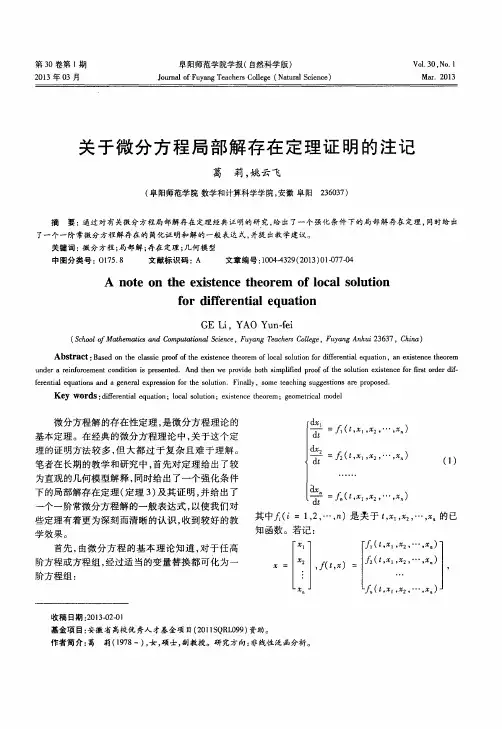
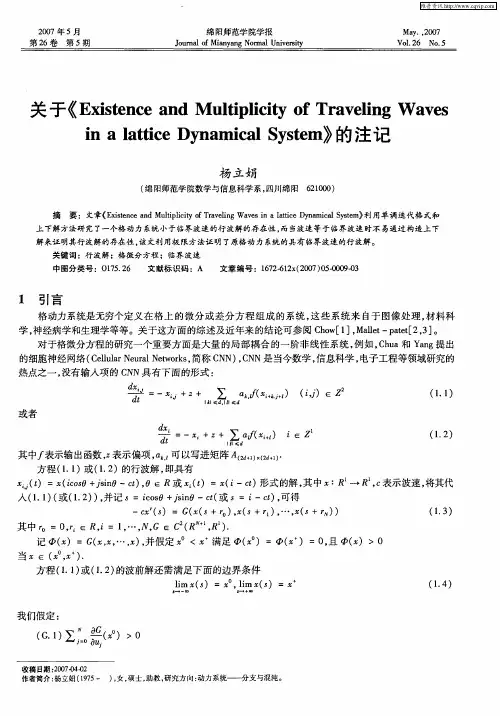
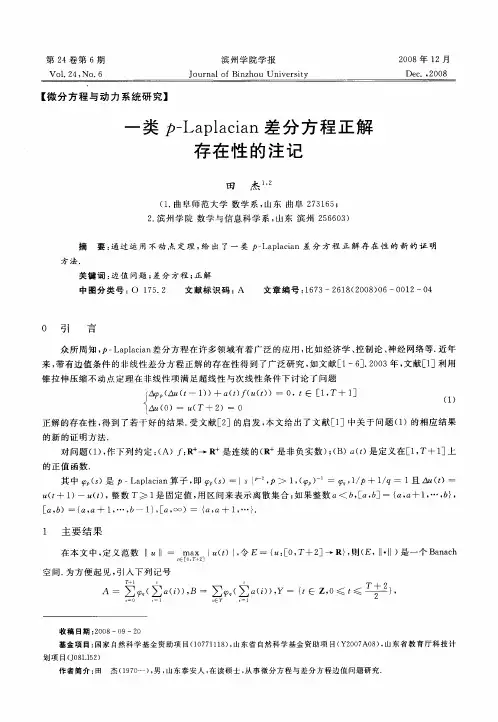
一类二阶hamilton系统周期解的存在性结论一类二阶Hamiltos系统是一科学研究的重要领域,其在物理、化学、生物、地球物理等多个领域具有广泛的应用。
它的研究重点在于推导出Hamilton系统的周期解。
近几十年,科学家们利用多种理论与方法,论证出一类二阶Hamiltos系统的周期解的存在性结论。
传统上,一类二阶Hamiltos系统论证过程分三步:给定方程中参数、变量的范围;利用数学分步法求解Hamilton系统的变量微分方程;通过对求解)(和微分方程步骤之间构造出利尔贝格等价恒定,并利用变量范围确定利尔贝格等式解集的完整性,从而论证出周期解存在性结论。
虽然这一方法完整存在,但其内容繁复,理论推导容易出现误差,很多时候无法获得满意的结果。
为了改进这种方法,一些科学家们从几何角度出发,提出了新的论证方法:利用反应力学把一类二阶Hamiltos系统表示为力学系统,并利用变量锥体分解方法,将问题转换为一系列的单个的三体问题,利用Moulton同步惯性理论推导出该三体系统的周期运行解。
接着,借助小步根,可以将三体系统的周期运行简化为状态线的运行过程,从而获得一类二阶Hamiltos系统的周期解的存在性结论。
此外,也有一些科学家利用拉格朗日方法证明了一类二阶Hamiltos系统周期解存在性结论。
在这种方法中,首先,用拉格朗日方法,将一类双摆系统的微分方程转化为Lagrange最优值问题,然后对对应的最优解进行Mather时间技术变换,在变换后的拉格朗日数的正确表达式上证明了一类二阶Hamiltos系统的周期解的存在性结论。
综上所述,已有许多关于一类二阶Hamiltos系统周期解存在性结论的结论,多种理论与方法均可对一类二阶Hamiltos系统论证其周期解存在性结论,从而为实际应用提供理论依据。
Journal of Mathematical Research&Ex positionVol.18,No.3,384-390,August1998Note on Existence of Periodic Solutions of One ClassDifferential Equ ations3Feng Zhaosheng(Dept.of Math.,Northern Jiaotong University,Beijing100044)Fei S humi n(Automatic Institute of S outheast University,Nanjing210096)Abstract In the present paper we investigate the number of periodic solutions of the following differential e2 quationdy dt =A1(t)y+A2(t)y2+A3(t)y3a0(t)+a1(t)y+a2(t)y2(33)which was discussed in paper[1,2],and obtain the theorem by the method of cross-ratio of the solutions of(33)without the traditional condition assum ption that the functions A i(t),a j(t)(i=1,2,3;j=0,1,2)are differential.K eyw ords differential equation,periodic solution,existence,transformation.Classif ication AMS(1991)34C25/CCL O175.121.IntroductionIt′s well-known that the question on the existence and the number of periodic solutions about differential equation plays an important role in the studies of nonlinear oscillation and the qualtative theory of ordinary differential equations.We see easily that the results in this area is useful to the exis2 tence and uniqueness of limit cycle of differential systems and applied widely in Physics and Engineer2 ing.Condsider the following differential equationdy dt =f(t,y)=A1(t)y+A2(t)y2+A3(t)y3a0(t)+a1(t)y+a2(t)y2.(1.1)Constructing one strip domain such that the solution of(1.1)y(t)in the boundary of this domain will not leave it,and then by using Brouwer fixed point theory,it is easy to get the theorems for the exis2 tence of periodic solutions of(1.1)[1,2].Comrade Lilin once obtained the theorem for the number of periodic solutions of(1.1)by the Lloyd′s method in[2]in the above theorem,however,it is needed3Received December21,1995.The sub ject supported by NJ U F.that the condition at the functions A i(t),a j(t)(i=1,2,3;j=0,1,2)is not only continuous T-pe2 riodic,but also differential(see Theorem2.1in[2]).Out results in this paper,obtained by the method of cross-ratio of solutions of(1.1),gives the sufficient conditions under which equation(1.1)has at most two non-trivial periodic solutions with2 out the traditional assumption that A i(t),a j(t)(i=1,2,3;j=0,1,2)are differential functions,as is well known such an assumption plays an important roal in the proofs of many results[1,2,etc].2.R esults in[2]Change equation(1.1)to following formdzdt=P0(t)+P1(t)z+…+P n(t)z n,(2.1) where P i(t)(i=0,1,2,…,n)are T-periodic functions,n may be inifinity,the number of T-pe2 riodic solutions of(2.1)has been discussed in paper[3,4],thus we can use these results for ours.First2 ly,we consider the problem to transform(1.1)into(2.1).G enerally,a0(t)+a1(t)y+a2(t)y2may be decomposed into(b0(t)+b1(t)y)(c0(t)+c1 (t)y),where b0(t),c0(t),b1(t),c1(t)are real functions,and b0(t)c0(t)=a0(t),b1(t)c1(t) =a2(t),b0(t)c1(t)+c0(t)b1(t)=a1(t).Here,we assume a21(t)-4a0(t)a2(t)>0,then this decomposition is suitable.Letr=yb0(t)+b1(t)y then y=b0(t)r1-b2(t)r.(2.2)Transformation(2.2)is topological in the neighbourhood of y=0.By the way,we always assume that the results of this section only hold in the neighbourhood of y=ing(2.2),(1.1)becomesdr dt =(B1r+B22r+B33r+B44r)-(b0rb0+(b0 b1-b1 b0)r2b0)(c0+er),(2.3)where the“・”denote the derivative with respect to t,ande=(a21-4a0a2)1 2,B1=A1 b0,B2=A2-3A1b1b0,(2.4)B3=A3b0-2A2b1+3A1b21b0,B4=A2b21-A3b0b1-A1b31 b0.Let z=rc0+er,thenr=c0z1-ez,(2.5)We can think transformation(2.5)is topological.By(2.5),(2.3)becomesdz dt =P1z+P2z2+P3z3+P4z41-ez(2.6)ordz dt =∑∞n=1P n z n,(2.7)whereP1=(B1- c0)c0-b0b0,P2= c0e-c0 e-2B1c1c0+B2+b0e-b0 b1+b1 b0b0,(2.8)P3=B3c0-B2c1+B1c21 c0,P4=B4c20,P5=B4c20e.Now,we assume B4=0,that isA3y2+A2y+A1=0,(2.9)where y=-b0(t)b1(t),then P k(k>3)of(2.7)is zero.By the results of[3],we give the followingTheorem If a i(t),A j(t)(i=0,1,2;j=1,2,3)are conti nuous dif f erential T-periodic f unc2 tions,(2.9)hol ds.Then w henB1+B2u+b3u2>0,(2.10)w here u=-c0(t)c1(t).equation(1.1)has at most t w o nont rivial T-periodic sol utions.Proof Since(2.9)holds,(2.7)becomesdzdt=P1z+P2z2+P3z3.(2.11) The results of paper[3]guarantee that(2.11)has at most three T-periodic solutions,when(2.10) holds,that is the P3of(2.11)is more than zero.Because z=0is one of T-periodic solutions of(2.11),and transformation(2.2),(2.5)are topological,then(1.1)and(2.7)has the same number of T-periodic solutions,that is,three.But z=0,that is,y=0is trivial.Then the conclusion of The2 orem2.1is true.3.Our Main R esultsFirstly,we introduce the following lemma which is needed in the proof of the Theorem. Lemma[5] If I is some open i nterval,y∈I,g′′(y)exists and g′′(y)≥0,and let a,b,c,d∈I such that a<b<c<d,then1d+c-b-a [d-bb-a∫bag(y)dy+c-ad-c∫dcg(y)dy]≥1c-b∫cbg(y)dy.(3.1)Which also can be writtend -c(c -a )(d -a )∫b a g (y )dy +b -a (d -b )(d -a )∫d c g (y )dy ≥(d -c )(b -a )(d +c -b -a )(c -a )(d -a )(d -b )(c -b )∫cb g (y )dy.(3.2)The equality sign holds if and only if g (y )is linear for y ∈[a ,d ].If g ′′(y )exists and g ′′(y )≤0,then the inequality sign of (3.1)and (3.2)is “≤”and the equality sign holds if and only if g (y )is linear for y ∈[a ,d ].We consider the differential equation (1.1).Where A i (t ),a j (t )(i =1,2,3;j =0,1,2)are con 2tinuous T -periodic functions ,may not be differential.Our main idea is similar to that of Theorem 1in paper [5],that is ,if i (t )(i =1,2,3,4)are four different T -periodic solutions on the samesubinterval J of I ,and f ′(t ,y )is concave (convex )in y for any fixed t ∈I ,by applying the lemma ,the cross -ratio (with the solutions properly number )R (t )=3(t )- 1(t ) 4(t )- 1(t ): 3(t )- 2(t ) 4(t )- 2(t ), t ∈J is monotone increasing (monotone decresing ),which contradicts with the hypothsis that R (t )is T -periodic.Here ,we als o assume that a 1(t )2-4a 0(t )a 2(t )>0,then a 0(t )+a 1(t )y +a 2(t )y 2may be decom 2posed into (b 0(t )+b 1(t )y )(c 0(t )+c 1(t )y ),where b i (t ),c i (t ),i =0,1;are real functions ,and b 0(t )c 0(t )=a 0(t ),b 1(t )c 0(t )=a 2(t ),b 0(t )c 1(t )+c 0(t )b 1(t )=a 1(t ),thus ,we have f (t ,y )=A 1(y )+A 2(t )y 2+A 3(t )y 3a 0(t )+a 1(t )y +a 2(t )y 2=A 1(t )y +A 2(t )y 2+A 3(t )y 3(b 0(t )+b 1(t )y )(c 0(t )+c 1(t )y )=d 0(t )b 0(t )+b 1(t )y +d 1(t )c 0(t )+c 1(t )y+d 2(t )y +d 3(t ).Which d i (t )(i =0,1,2,3)satisfy that d 0c 0+d 1b 0+d 0c 1y +d 1b 1y +(d 2y +d 3)(a 0+a 1y +a 2y 2)=A 1y +A 2y 2=A 3y 3,that isd 0c 0+d 1b 0+d 3a 0=0d 0c 1+d 1b 1+a 0d 2+d 3a 1=A 1d 2a 1+d 3a 2=A 2d 2a 2=A 3 则(3.4) We define thatΩ1denotes the domain{y:b0(t)+b1(t)y>0and c0(t)+c1(t)y>0},Ω2de2 notes the domain{y:b0(t)+b1(t)y>0and c0(t)+c1(t)y<0}∪{y:b0(t)+b1(t)y<0and c0 (t)+c1(t)y>0}andΩ3denotes the domain{b0(t)+b1(t)y<0and c0(t)+c1(t)y<0}.Derivate f(t,y)in y,we havef′(t,y)=d2-d0b1(b0+b1y)2-d1c1(c0+c1y)2,f″(t,y)=2d0b21(b0+b1y)3+2d1c21(c0+c1y)3,f (t,y)=-6d0b31(b0+b1y)4-6d1c31(c0+c1y)4.Thus,we obtain the followingTheorem1 If A i(t),a j(t)(i=1,2,3;j=0,1,2)are conti nuous T-periodic f unctions,a21-4a0a2>0,and-d0b1≥0,-d1c1≥0,(or-d0b1≤0,-d1c1≤0).Then equation(1.1) has at most t w o non-t rivial T-periodic sol utions at the dom ai nΩ1orΩ2orΩ3.Proof We discuss the case at the domainΩ1the other cases is treated analogously.Recall that through any point(t0,ζ)∈I×R,there passes a unique maximal solution (t,t0,ζ)(t∈I(t,ζ)of(1.1)),in the following t0∈[0,T]is arbitrary,but fixed.Next,we assume i(t)= (t,t0,ζi)(i=1,2,3,4;ζ1<ζ2<ζ3<ζ4)are four different T-pe2 riodic solutions of(1.1)on the same interval J<I,and such that 1< 2< 3< 4. From(1.1),we get ・2(t)- ・1(t) 2(t)- 1(t)=∫ 2(t)1(t)f′(t,y)2(t)- 1(t)dy, t∈J.(3.5) And by intergrationIn 2(t)- 1(t)ζ2-ζ1=∫∫a(t)f′(τ,y)2(τ)- 1(τ)dτdy,(3.6)where a(t)denotes the domain t0≤τ≤t, 1(t)≤y≤ 2(t)(see Fig.1).From(3.1)and(3.6), we getIn R(t)R(t0)=∫∫a(t)∪b(t)f′(τ,y)3(τ)- 1(τ)dτdy-∫∫a(t)∪b(t)∪c(t)f′(τ,y)4(τ)- 1(τ)dτdy- ∫∫b(t)f′(τ,y)3(τ)- 2(τ)dτdy+∫∫b(t)∪c(t)f′(τ,y)4(τ)- 2(τ)dτdy=∫∫a(t) 4- 3( 3- 1)( 4- 1)f′(τ,y)dτdy+ ∫∫c(t) 2- 1( 4- 2)( 4- 1)f′(τ,y)dτdy- ∫∫b(t)( 4- 3)( 2- 1)( 4+ 3- 2- 1)( 3- 1)( 4- 1)( 4- 2)( 3- 2)f′(τ,y)dτdy,(3.7)where b(t)denotes the domain t0≤τ≤t, 2(t)≤y≤ 3(t),and c(t)denotes the domaint0≤τ≤t, 3(t)≤y≤ 4(t). Suppressing the variable τof intergration in the last three integrals ,let g (y )=f ′(t ,y ),putting a = 1(τ),b = 2(τ),c = 3(τ),and d = 4(τ)in (3.2),clearly ,g ″(y )≥0(or g ″(y )≤0),y ∈R ,for any fixed τ∈[t 0,t ],hence we may apply the lemma ,we obtain4- 3( 3- 1)( 4- 1)∫ 2 1f ′(τ,y )dy + 2- 1( 4- 2)( 4- 1)∫ 4 3f ′(τ,y )dy -( 4- 3)( 2- 1)( 4+ 3- 2- 1)( 3- 1)( 4- 1)( 4- 2)( 3- 2)∫3 2f ′(τ,y )dy >0.(3.8) Integrating the above inequality with respect to τfrom t 0to t ,we get the last expression in (3.7)to be positive.Thus ,we conclude that R (t )is monotone incresing ,that is ,R (0)<R (t ),which yields a contradiction with the fact that R (t )is a T -periodic function by the hypothsis.So (1.1)has at most three T -periodic solutions at the domain Ω1(Ω2or Ω3),but y =0is trivial ,then the proof of Theorem is completed.If a 21-4a 0a 2<0,we haveA 1y +A 2y 2+A 3y3a 0+a 1y +a 2y 2=A 3a 2y +A 2a 2-A 3a 1a 22+Ey +F a 0+a 1y +a 2y 2,where E =A 1-A 3a 0a 2-A 2a 2a 1-A 3a 21a 22,F =A 3a 1a 0-A 2a 2a 0a 22.Similar to the proof of Theorem 1,we haveTheorem 2 If A i (t ),a i (t )(i =1,2,3;j =0,1,2)are conti nuous T -periodic f unctions ,a 21-4a 0a 2<0,and[Ey +Fa 0+a 1y +a 2y 2]″≥0 (or ≤0).Then equation (1.1)has at most t w o non -t rivial T -periodic sol utions at the dom ai n Ω1or Ω2or Ω3.R eferences[1]Lilin ,Existence of periodic about one class dif f erential equation and its application ,Ann.of Diff.Equs.,5:4(1989),427-434.[2]Lilin ,Existence of periodic about one class dif f erential equation ,Chinese Quarterly Journal of Mathematics ,4:7(1992),20-25.[3]N.G.Lloyd ,the N umber of periodic of the equation dz dt=P 0(t )+P 1(t )z +…+P n (t )z n ,Proc.London Math.S oc.,27:3(1973),667-700.[4]N.G.Llody ,On analytic dif f erential equation ,Proc.London Math.S oc.,30:3(1975),430-444.[5]Feng Zhaosheng ,On periodic solutions of a class of Riccati equation w ith eriodic coef f icients ,Journal of NorthernJiaotong University ,2(1997).[6]Feng Zhaosheng ,Existence of periodic solutions of second order neut rale quation ,Journal of Beijing University ofAeronautics and Astronautics ,21:2(1995),114-118.[7]Feng Zhaosheng and Guan K eying ,On the non -oscillation solution and their asym ptotic behavior of a class of Ric 2cati equation ,Journal of Nonlinear Dynamics in Science and Technology ,(1995),S pecial Number 209-215.[8]Guan K eying and G ao Guo,Qualtative analysis of the solutions of mixed Bergers-KdV equation,Chinese Science,A:1(1987),64-73.关于一类微分方程周期解的存在性的注记冯兆生(北方交通大学数学系,北京100044)费树岷(东南大学自动化所,南京210096)摘 要本文主要探讨下列周期系数微分方程dy dt =A1(t)y+A2(t)y2+A3(t)y3a0(t)+a1(t)y+a2(t)y2(33)的周期解个数问题,利用方程(33)解的差率法得到了方程(33)周期解的个数定理.本文仅在A i(t),a j(t)(i=1,2,3,j=0,1,2)是连续周期函数的条件下得到这一结论,从而减弱了文[2]中相应定理的条件,即A i(t),a j(t)均是连续可微的周期函数.。